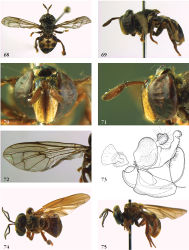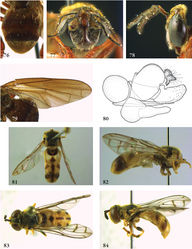Furcantenna
| Notice: | This page is derived from the original publication listed below, whose author(s) should always be credited. Further contributors may edit and improve the content of this page and, consequently, need to be credited as well (see page history). Any assessment of factual correctness requires a careful review of the original article as well as of subsequent contributions.
If you are uncertain whether your planned contribution is correct or not, we suggest that you use the associated discussion page instead of editing the page directly. This page should be cited as follows (rationale):
Citation formats to copy and paste
BibTeX: @article{Reemer2013ZooKeys288, RIS/ Endnote: TY - JOUR Wikipedia/ Citizendium: <ref name="Reemer2013ZooKeys288">{{Citation See also the citation download page at the journal. |
Ordo: Diptera
Familia: Syrphidae
Name
Furcantenna Cheng – Wikispecies link – Pensoft Profile
- Furcantenna Cheng, 2008: 29 (in Cheng and Thompson 2008[1]). Type species: Furcantenna yangi Cheng, 2008: 29, by original designation.
Description
Body length: 9–10 mm. Broadly built flies with very wide head, long antennae and widened hind tibiae, bee mimics. Head much wider than thorax. Face slightly convex in profile; wider than eye; laterally depressed; medially weakly carinate. Lateral oral margins not produced. Vertex produced. Occiput ventrally narrow, dorsally widened. Eye bare. Eyes in male not convergent at level of frons; separated over distance much larger than width of antennal fossa. Antennal fossa about as high as wide. Antenna much longer than height of head; basoflagellomere bifurcate at base, with ventral branch a little longer than dorsal branch, both branches entirely long pilose; arista absent. Postpronotum pilose. Anepisternum sulcate. Scutellum apicomedially sulcate. Katepisternum dorsally pilose. Metasternum developed and pilose. Wing: vein R4+5 without posterior appendix; vein M1 perpendicular to R4+5 and M; crossvein r-m located around basal 1/5 of cell dm. Hind tibia and tarsus widened. Abdomen oval. Male genitalia: phallus slightly bent dorsad, with large spherical base; phallus furcate near apex; epandrium without ventrolateral ridge; surstylus approximately oval. Females unknown.
Diagnosis
Male with bifurcate basoflagellomere. Katepisternum pilose. Metasternum pilose.
Diversity and distribution
Described species: 2. The type species was found in a mountainous area in southeastern China. The second known species, Furcantenna nepalensis sp. n., was collected in the Nepalese Himalaya at an altitude of approximately 1800 meters. The discovery of these species in these areas sheds an interesting light on the biogeography of the taxa with a furcate basoflagellomere in the male. Prior to the description of Furcantenna, such taxa were almost exclusively known from South America (except for the the apparently unrelated Australian Cervicorniphora). The occurrence of the obviously related (Reemer and Ståhls in press[2]) Furcantenna in Oriental mountains on the Asian mainland could possibly be explained as a relict of a wider distribution in early eras.
Taxon Treatment
- Reemer, M; Ståhls, G; 2013: Generic revision and species classification of the Microdontinae (Diptera, Syrphidae) ZooKeys, 288: 1-213. doi
Other References
- ↑ Cheng X, Thompson F (2008) A generic conspectus of the Microdontinae (Diptera: Syrphidae) with the description of two new genera from Africa and China. Zootaxa 1879: 21-48.
- ↑ Reemer M, Ståhls G (in press) Phylogenetic relationships of Microdontinae (Diptera: Syrphidae) based on parsimony analyses of combined molecular and morphological characters. Systematic Entomology 38.
Images
|

